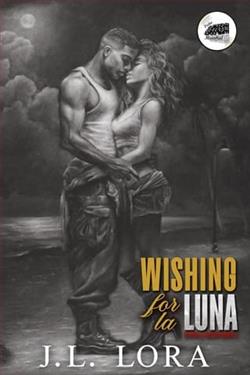Page 20 of A Talent for Murder
The door to the bathroom swung inward and April padded in. She wasn’t my cat, exactly, although I’d named her for the month, two years ago, when she’d first shown up at our house uninvited. She came and went as she pleased, mostly visiting the barn, where I left her food, and it had been a while since she’d come inside the actual house. She sat on the bathroom tile and looked at me. “It’s called a bath,” I said.
When I got out from the cooling water, she sashayed back out the way she’d come in.
That night, while my mother watched PBS mysteries, I sat next to her on the couch with my laptop and found out everything I could about Josie Nixon and her husband, Travis. There were really very few newspaper articles about her death, but there was an obituary in the Albany newspaper, and there was a remembrance page on which people had left comments about Josie and the hole she’d left behind.
There were multiple images online, including several that came from Travis and Josie’s wedding website. They’d met at art school five years earlier and gotten married two years after that. They both looked as though they were in their late twenties. Josie had a pale, round face and long hair that she’d dyed jet-black. She wore a lot of high-necked white shirts, but in the few pictures where she was showing some skin, it was clear that her arms were covered in tattoos. Her husband could have passed as her brother. Same sallow face but a little rounder, and he had a waxed mustache. On their wedding day she’d been in a traditional white dress and he’d been in a dark shimmery tux, but in every other picture of them he was wearing black jeans and graphic T-shirts, while she was usually wearing black velvety skirts, shirts with brooches, or vintage sweaters, her inky hair parted in the middle. Like Wednesday Addams, I thought, then remembered that Wednesday Addams had worn her hair in pigtails. Josie’s husband was a graphic designer and aspiring comic book artist. They had lived in Woodstock, New York.
A little while ago I had created a false Instagram account under the name Rose Sheldon. This was back around the time I was helping Henry Kimball with the case that nearly got him killed. I logged on to my fake page, not entirely surprised to find that I’d acquired a few new followers, including a man who’d sent me a message that began, Hello, beautiful... despite there being only three posts on my page, two of April the cat, and one of the white rosebush in our front yard. I found Travis Nixon’s page. It wasn’t private, and I was able to scroll through hundreds of photographs. He’d been clearly enamored of his wife before she died, but since then every post was of her, along with a long text about how the police had stopped looking for her murderer. Every post ended with the hashtag: #JusticeForJosie.
I amended my fake Instagram bio so that instead of it saying “Gardener, amateur detective, adventuress,” it read “Independent journalist. Looking for stories no one else wants to tell.” Then I sent a message to Travis Nixon: Hi Travis. I’d be interested in doing a piece about the death of your wife. Would you consent to an interview? I have no agenda besides uncovering the truth. Regards, Rose Sheldon.
I sent it off, then immediately regretted it, thinking I should have given it a little more thought. All Travis would have to do was google “Rose Sheldon” to discover that she’d never published a single article. He’d identify me as an impostor, and probably conclude that I was some sort of con artist. I thought about other ways to approach him. I could be honest, of course, without giving him any real names. Just let him know that I had a friend who suspected her husband of targeting women at teacher conferences. But he’d insist on knowing more. From looking at his online presence, it was clear that he was deeply obsessed with the death of his wife.
I was thinking of closing my laptop and getting ready to go to bed when I received a response. Rose. Thank you, thank you for reaching out. I’d love to tell you my story. In person? On the phone? I live in Woodstock but would be willing to travel. Travis.
I wrote back that I’d be willing to meet him in Woodstock for lunch at noon the following day. He seemed ecstatic and named a place called the Dove and Hare.
After sending that text I decided to call Martha. She picked up right away, and there was a breathless quality to her voice, as though she were waiting for bad news.
I told her what I’d learned, and my plans for tomorrow.
“Okay, wow,” she said. “But even if he’s convinced she was murdered, it might not mean she was.”
“I’ll talk to him and see. But, yes, he’s obviously going to try and plead his case. In the meantime, you and I should start making some phone calls, do some research.”
“Like what?”
“We could call the police departments in the cities where you found those crimes. Tell them we’re working for a private investigator, and ask for updates. They’ll either talk to us or they won’t, but you never know. We could also call crime reporters in those cities. That might work.”
“I think I could do that,” Martha said, but she sounded doubtful.
“It’s worth a shot. We might get a chatty cop. Stranger things have happened.”
“Okay, sure,” she said. “I could definitely try. I can actually start tomorrow. Alan’s here, but he’ll be gone most of the day tomorrow. He told me he’s doing an inventory count and that will take him most of the day. I’ve already told him I’m coming down with something, so I’ll call in sick to work.”
We talked some more about questions to ask, and I could tell that she was starting to get excited about the assignment I’d given her. She was a librarian, after all, and there’s nothing a librarian likes more than an assignment.
Chapter10
In the morning Martha emailed the library to let them know she was taking a sick day, then she let Alan bring her breakfast in bed. After he had left the tray she listened to him move around downstairs, preparing to leave for the day. Now that she’d decided to make some calls she was nervous, but wanting to get a start on her research.
At last she heard the front door open and shut and then the faint sound of his car starting up. She quickly got out of bed, dressed in yoga pants and a sweatshirt, and went downstairs to the computer. They still had a landline in the house, and there was a desk phone next to the computer.
The first few conversations did not go well. Martha tried her best to sound like a jaded investigator, someone who expected to receive information. The first police detective she reached was in the Atlanta Police Department, a Detective Gunter, who had worked the Kelli Baldwin case. She was the only victim on Martha’s list who had been identified in the press as a prostitute. She’d died from blunt-force trauma to the head late at night while returning to her apartment in north Atlanta, three miles from downtown where the convention was being held. Martha asked the detective if he had any leads, and he’d told her that she was a junkie and a prostitute, and it could have been anyone she knew.
“Did she work the convention hotels?” she asked.
“The convention hotels? Nope. She was a strung-out street hooker who worked over by Piedmont Park.”
“But it’s possible that someone from a downtown hotel might have cruised that area looking for a pick-up?”
“Anything’s possible, lady. For all I know, it was some tourist from China who’d read about the hot hookers on the Ponce de Leon. I can’t help you.”
Her next call was to Chicago, and she was shuffled around from department to department for thirty minutes before being connected with an Officer Wood, who was able to take a look at the file on Bianca Muranos, found dead in an alleyway behind the DoubleTree Conference Center in Chicago. She had been killed by blunt-force trauma, as well. And, as in Atlanta, no weapon had been found.
Martha asked Officer Wood if Bianca had been a prostitute, and listened while he whistled to himself, flipping through the case file. “Not according to this. She worked as a receptionist at one of the big downtown office buildings.”
“And there were no leads?”















